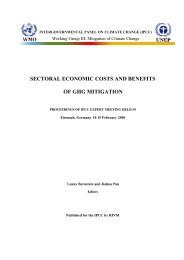Pacific Islands Environment Outlook - UNEP
Pacific Islands Environment Outlook - UNEP
Pacific Islands Environment Outlook - UNEP
You also want an ePaper? Increase the reach of your titles
YUMPU automatically turns print PDFs into web optimized ePapers that Google loves.
INTRODUCTION<br />
xiii<br />
●<br />
●<br />
●<br />
on many islands have exceeded the level that local<br />
resources can sustain.<br />
Limited land resources: Many <strong>Pacific</strong> islands are<br />
characterized by extremely limited land resources<br />
such as soil and forest. Limited land makes many<br />
terrestrial and nearshore resources very vulnerable<br />
to overexploitation and to pollution from poorly<br />
planned waste disposal.<br />
Dependence on marine resources: There is a traditional<br />
dependence on marine resources for daily needs,<br />
foods, tools, transport and waste disposal. This<br />
dependence remains in spite of new technologies and<br />
lifestyles (see National <strong>Environment</strong> Management<br />
Strategies 1992–94). The region’s ocean resources<br />
contain the highest marine diversity in the world and<br />
represent almost the sole opportunity for substantial<br />
economic development for nations such as the<br />
Marshall <strong>Islands</strong>, Kiribati and Tuvalu.<br />
Vulnerability: The <strong>Pacific</strong> is often exposed to<br />
extremely damaging natural disasters and to external<br />
and global changes (for instance in climate, trade and<br />
capital markets), and has a heavy reliance on certain<br />
economic sectors (Thistlethwaite and Votaw 1992).<br />
being implemented in the region. A review of the current<br />
policy responses is provided in Chapter Two, whilst<br />
alternative policy options for the future are addressed in<br />
Chapter Three. Chapter Four provides an analysis of<br />
emerging issues in the region.<br />
The priority environmental problems that are placing<br />
pressure on the natural resources, lifestyles and<br />
economic development of this region have been<br />
identified progressively over the last eight years as:<br />
●<br />
●<br />
●<br />
●<br />
●<br />
loss of biological diversity;<br />
threats to freshwater resources;<br />
degradation of coastal environments;<br />
climate change and sea level rise;<br />
land and sea based pollution.<br />
These priorities have been drawn from national state of<br />
the environment reports prepared between 1991 and<br />
1994 for National <strong>Environment</strong>al Management Strategies,<br />
regional reviews of state of the environment reporting<br />
(Thistlethwaite 1996), the Strategic Action Programme<br />
for International Waters in the <strong>Pacific</strong> Island Region<br />
(1997) and the SPREP Action Plan (1997–2000). They<br />
are reflected in international agreements reached<br />
concerning the sustainable development of islands,<br />
notably the Global Programme of Action for the<br />
Sustainable Development of Small Island Developing<br />
States and related preparatory meetings (SPREP 1993c).<br />
The priority problems are explored in Chapter One.<br />
They also provide the focus of attention for the range of<br />
national, regional and global policy initiatives that are

















